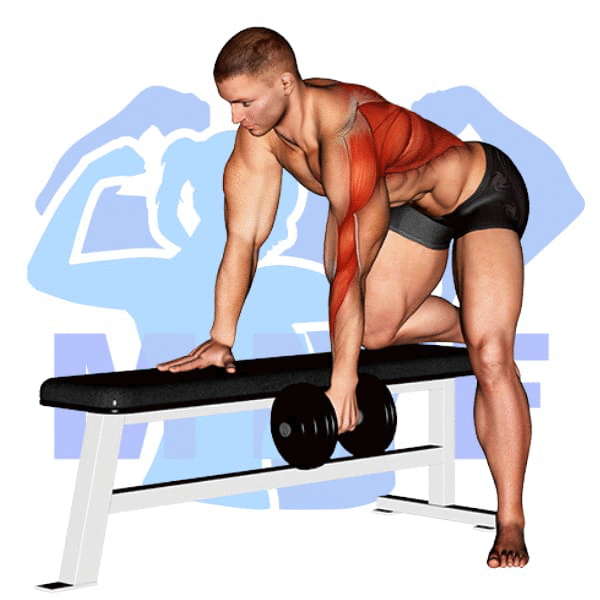If you spend a lot of time at your desk or sitting, you’ve likely experienced nagging lower back pain. Sometimes, even standing and stretching won’t provide the relief you need. You’re not alone. Many people face this problem every day, and one common cause is weak glutes and hamstrings. The solution you might not have considered is incorporating bench hyperextensions into your workouts. In this post, we’ll explain what bench hyperextensions are, why they’re a valuable exercise, and how they can help alleviate lower back pain.
Bench Hyperextension Summary
- Primary Muscles: Erector Spinae
- Secondary Muscles: Gluteus Maximus, and Hamstrings
- Equipment: Flat Bench
- Mechanics Type: Compound
- Force: Pull
- Utility: Basic or Auxiliary
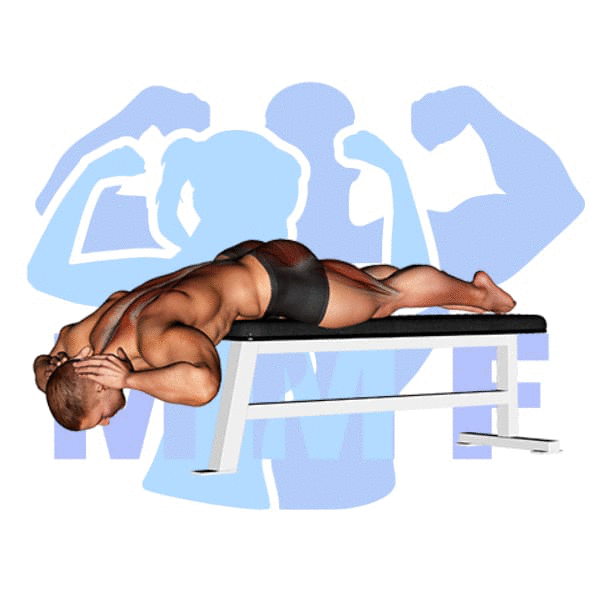
Bench Hyperextension Instructions
- Get started by laying down on a bench so your legs and hips are on the bench and your stomach hangs over the end.
- Lower your upper body towards the ground.
- Once you reach your lower limit, pull your body back up with your lower back.
- Repeat the Bench Hyperextension for a complete set.
Video Tutorial
Bench Hyperextension Muscles
Target (Agonist)
Synergists
Dynamic Stabilizers
- None
Stabilizers
Antagonist Stabilizers

Benefits of Bench Hyperextension
The Bench Hyperextension exercise is a great way to target the muscle known as the Erector Spinae, which is located along the spine. This exercise can help to increase flexibility, strength, and stability in the back, while also helping to improve posture. Additionally, it can help to reduce pain and discomfort that may be caused by tightness or tension in the muscles of the back. By performing this exercise on a regular basis, you can strengthen your core and help to improve your overall physical fitness.
Tips for Performing Bench Hyperextension
You’ve come at the right place if you desire to forge ahead your ability to conduct bench hyperextension. Using these suggestions can allow you to take full advantage of this effective workout. Concurrently with building your back and core muscles, increasing movability, and also a lower possibility of injury can all be accomplished with this exercise. Let’s get begin and look at what these tips can do for you.
- Start with a Lower Rep Count: Start with 8-10 reps per set to get the hang of the exercise before increasing the reps. This will help you avoid injury and build strength gradually.
- Use Proper Form: Make sure to keep your torso in a straight line and not bend at the waist. This will help you maximize the benefits of the exercise and minimize injury.
- Increase Resistance: If you find that you can easily do 8-10 reps, increase the resistance by adding a pause at the top of each rep. This will increase the intensity of the exercise and give you better results.
Benefits and Tips Video
Frequent Mistakes To Avoid
When conducting bench hyperextension, avoiding common errors can be the difference to achieving optimal results and avoiding pain. Moreover, getting optimal results from this exercise requires proper form, and making sure you don’t make any typical errors can allow you to perform the exercise better and obtain your desired results. But don’t worry, it’s not at all difficult as it might appear. You can execute the exercise safely and efficiently by avoiding the mistakes to prevent and by executing the correct steps. Let’s start by staying away from these typical mistakes and add this exercise to your training regimen.
- Not using proper form: One of the most common mistakes people make when conducting the body weight exercise Bench Hyperextension is not using proper form. This can lead to straining of the muscles and an increased risk of injury.
- Not allowing the body to fully extend: Another common mistake people make when doing the body weight exercise Bench Hyperextension is not allowing the body to fully extend. Not extending completely can prevent the muscles from getting a full stretch and decrease the effectiveness of the exercise.
- Not engaging the core muscles: People often neglect to engage their core muscles when performing this exercise, which can lead to poor posture and an increased risk of injury. Engaging the core muscles will help to ensure that you are using proper form and will help to maximize the benefits of the exercise.
Find More Bodyweight Exercises Here
Variations and Complementary Exercises
If you’re looking for variations, complementary, or alternative exercises to the Bench Hyperextension, then the following list will be of help. These exercises work similar muscles as the Bench Hyperextension and can be done to supplement the original exercise.
Hyperextension
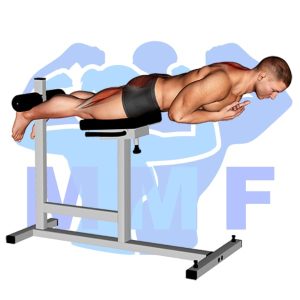
Hyperextension is a great complementary or alternative exercise to the Bench Hyperextension. This exercise works the lower back and core muscles, helping to improve posture and balance. The Hyperextension works by engaging the glutes and hamstrings while the user leans backward with their arms extended behind them. This exercise helps to strengthen and stabilize the spine and core muscles and can be done on a special bench or on the floor. The main benefit of this exercise is that it is safe for those with existing lower back pain, as it does not require any external weight. It can also be done in a variety of ways, from basic to more challenging, which makes it suitable for all fitness levels.
Reverse Hyperextension

Reverse Hyperextension is a complementary or alternative exercise to the Bench Hyperextension. The exercise involves lying face down on the reverse hyperextension machine, with the legs and hips supported by a padded roller and feet braced against a foot platform. The person then bends the hips up and back while keeping the back flat and legs straight. This exercise works the hamstrings, glutes, and lower back muscles, which are all important in maintaining proper posture and helping to prevent back injury. Reverse hyperextensions are an effective way to strengthen the core muscles and can be used as an alternative to the bench hyperextension for those looking for a more challenging workout.
Plate Hyperextension

Plate Hyperextension is a great complementary or alternative exercise to the Bench Hyperextension. It works the same muscles, but with a slightly different movement pattern. Plate Hyperextension exercises require you to lift and lower a weighted plate while bent over at the waist. This exercise focuses on strengthening the back muscles and also helping to stabilize the core and improve balance. Plate Hyperextension can be done with either a straight bar or an adjustable weight bench, making it a great option for those who are looking for an alternative to the Bench Hyperextension.
Check Out These Top Bodyweight Exercises
Barbell Good Morning
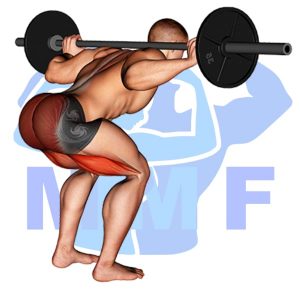
The Barbell Good Morning is a great complementary exercise to the Bench Hyperextension. This exercise works the lower back muscles, hamstrings, and glutes. It is performed by standing with your feet shoulder-width apart and holding a barbell across the back of your shoulders. From there, you must bend forward at the hips while keeping your back straight. This exercise helps strengthen and stabilize the lower back muscles which can be beneficial in preventing injury while doing the Bench Hyperextension. Additionally, it can be used as an alternative exercise to the Bench Hyperextension when one has limited equipment or when one is looking for a lower impact workout.
Good Mornings With Bands

Good Mornings With Bands are a great complementary or alternative exercise for the Bench Hyperextension. This exercise works the glutes, hamstrings, and lower back while also helping to improve core stability. Unlike the Bench Hyperextension, which requires a bench and the use of your bodyweight, Good Mornings With Bands are an excellent way to add resistance to the exercise without the need for any equipment. The bands provide resistance to the hip hinge movement, allowing for a deeper range of motion and increased muscle activation. Good Mornings With Bands are also a great way to increase the intensity of your workout without putting too much strain on your lower back.
Smith Machine Good Morning Off Pins
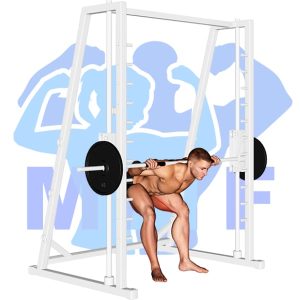
The Smith Machine Good Morning Off Pins is a great alternative or complementary exercise to the Bench Hyperextension. It is an exercise that works the same muscles as the Bench Hyperextension, but with a different range of motion. The Smith Machine Good Morning Off Pins allows you to target the muscles of the lower back and hips more specifically, while still engaging the core muscles. Additionally, this exercise allows you to adjust the angle and range of motion to suit your specific needs, making it a great alternative or complementary exercise to the Bench Hyperextension.
Find More Lower-Back Exercises Here
Opposing Complementary Exercises
These exercises should be used to complement the Bench Hyperextension exercise in order to ensure that opposing muscle groups are also worked. This will help keep the body in balance and prevent any muscular imbalances from developing. Below is a list of exercises that target the muscles that oppose those used in the Bench Hyperextension exercise.
Jack Knife Sit Up
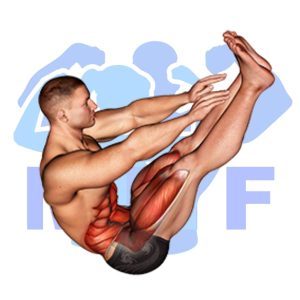
The Jack Knife Sit Up is a great complement to the Bench Hyperextension exercise. It works the opposing muscle group in a similar way. The Jack Knife Sit Up focuses on the abdominal muscles, while the Bench Hyperextension works the lower back muscles. This combination helps to strengthen the entire core and promote balance between the two muscle groups. Furthermore, it is an effective way to increase both flexibility and strength in the core region. By combining these two exercises, you can achieve a comprehensive core workout that will help to improve your overall fitness level.
Incline Leg Hip Raise

The Incline Leg Hip Raise is the perfect complement to the Bench Hyperextension exercise, as it works the opposing muscle group. The Incline Leg Hip Raise targets the hip flexors, which are the muscles that oppose the glutes and hamstrings worked by the Bench Hyperextension. This exercise is great for developing strength and stability in the lower body, as well as helping to improve posture and balance. Additionally, this exercise can help to reduce lower back pain, making it a great choice for those who experience chronic discomfort in the area.
Hanging Leg Raise

The Hanging Leg Raise is an excellent complement to the Bench Hyperextension as it works the opposing muscle group. This exercise targets the lower abdominal muscles, hip flexors, and obliques, while the Bench Hyperextension targets the lower back and glutes. By performing both exercises, you can ensure that your core is balanced and strong, which is essential for overall health and wellbeing. Additionally, the Hanging Leg Raise helps to improve posture and balance, while the Bench Hyperextension strengthens and stabilizes the lower back. Together, these two exercises can help to develop a strong and balanced core.
Boost Your Bench Press Results with Hyperextensions
Another way to improve your bench press results is to incorporate hyperextensions into your workout routine. Hyperextensions strengthen the lower back muscles, which play a crucial role in stabilizing the body during heavy bench press lifts. By strengthening this area, you will be able to maintain proper form and transfer more power from your legs and core to your upper body. In addition, hyperextensions can help prevent injuries that may occur due to a weak lower back. Add hyperextensions to your routine 1-2 times per week, keeping in mind proper form and gradually increasing weight over time for optimal results.
References: Wikipedia | ExRx.net | PubMed.gov | Comprehensive List of Lower-Back Bodyweight Exercises

